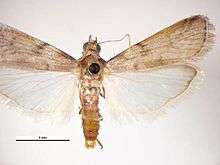Amyelois
Amyelois is a monotypic snout moth genus described by Hans Georg Amsel in 1956. Its single species, Amyelois transitella, the navel orangeworm, described by Francis Walker in 1863, is endemic to the tropical Western Hemisphere, including the southern United States.[2][3] Its abundance in California increased greatly during the first half of the 20th century.[4][5][6]

| Amyelois | |
|---|---|
 | |
| Male | |
 | |
| Female | |
| Scientific classification | |
| Kingdom: | |
| Phylum: | |
| Class: | |
| Order: | |
| Family: | |
| Genus: | Amyelois |
| Species: | A. transitella |
| Binomial name | |
| Amyelois transitella (Walker, 1863) | |
| Synonyms | |
| |
The wingspan is 9.7 to 10.9 mm. Adults are on wing from the end of March to the end of October in California.
The larvae are considered a commercial pest of a number of California crops, including walnut (Juglans regia), fig (Ficus carica), almond (Prunus dulcis) and pistachio (Pistacia vera).
Pheromones
Female A. transitella release very similar sex pheromones to that of female Pyralis farinalis. Both species release the pheromone (Z,Z)-11,13-hexa decadienal which is used to attract males. Male P. farinalis have been observed attempting to mate with female A. transitella, but it does not seem as though these copulations are successful in producing offspring.[7]
References
- "GlobIZ search". Global Information System on Pyraloidea. Retrieved August 26, 2017.
- Heinrich, C. 1956. American moths of the subfamily Phycitinae. Bulletin of the United States National Museum 207: 1-581.
- Solis, A. M. 2006. Key to Selected Pyraloidea (Lepidoptera) Larvae Intercepted at U.S. Ports of Entry: Revision of Pyraloidea Archived 2017-08-27 at the Wayback Machine in "Keys to some frequently intercepted lepidopterous larvae" by Weisman 1986. U.S. Department of Agriculture, Agricultural Research Service, Washington, D.C.
- Simmons, P., W. D. Reed, and E. A. McGregor. 1931. Circular No. 157: Fig Insects in California, United States Department of Agriculture, Bureau of Entomology, Washington, DC.
- Wade, W. H. 1961. Biology of the navel orangeworm, Paramyelois transitella (Walker), on almonds and walnuts in northern California. Hilgardia 31: 129-171.
- Simmons, P., and H. D. Nelson. 1975. Insects on Dried Fruits. Agriculture Handbook 464, vol. Agricultural Research Service, United States Department of Agriculture, Washington, DC.
- Landolt, P. J.; Curtis, C. E. (1982). "Interspecific Sexual Attraction between Pyralis farinalis L. and Amyelois transitella (Walker) (Lepidoptera: Pyralidae)". Journal of the Kansas Entomological Society. 55 (2): 248–252. JSTOR 25084280.
External links
- Sexual behavior of the navel OrangeWorm, Amyelois transitella (Walker) (Lepidoptera: Pyralidae)
- Bug Guide
- IPM for Navel Orangeworm
| Wikimedia Commons has media related to Amyelois. |
| Wikispecies has information related to Amyelois |